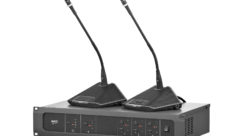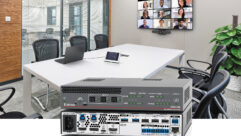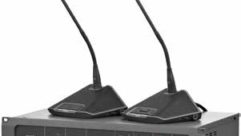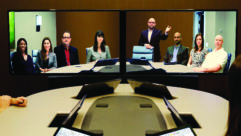
LifeSize Team HD
Feb 1, 2007 12:00 PM,
By Jeff Sauer
Videoconferencing system brings HD to the boardroom.

Videoconferencing may be one of the easiest technologies for the average person to understand. Traditionally, the term has basically meant telephone communication with video added. As a society, we’ve been hearing about this concept since the days of The Jetsons and the original Star Trek. But in the real world, it’s taken decades to deliver on that promise, and it’s no mystery why: Moving video over phone wires — or, more recently, IP networks — is no small matter, particularly given the quality expectations of a society weaned on television.
Now, however, videoconferencing has reached a confluence of technologies that makes visual communications not only possible, but also practical and accessible, and LifeSize Communications has had a lot to do with it. By forcing the industry to embrace high-definition video, LifeSize has given video-conferencing in general a measure of quality that makes it a solution, rather than a technology. The LifeSize Team system ($7,999) is a good example of how straightforward high-quality video-conferencing can be.
LifeSize Team targets small- to medium-size organizations, and is the younger sibling of the LifeSize Room system ($11,999). The two are very similar in terms of basic features and quality. Both include a LifeSize codec; cables; a native 16:9 HD pan/tilt/zoom camera; a handheld remote; and a circular 16-microphone, dial-pad phone module. The difference lies in LifeSize Room’s support for dual-monitor configurations, serial control, and a few other added connection options, as well as the ability to act as a multi-point bridge to connect up to four parties. LifeSize Team, on the other hand, supports three-way videoconferencing.
Neither system includes the display, although either can be connected to any 720p-capable display already in a conference room. Therefore, the videoconferencing system could be fed through an already installed conference room front projector, rear-projection monitor, or flatpanel display.
The LifeSize Team codec chassis has connection ports for the phone module and HD camera, as well as analog HD component video and RCA audio monitor out, a 15-pin RGA input for a presentation computer, and the Ethernet connection. There are S-Video and composite video inputs for connecting other video sources, such as a DVD player, camcorder, or video deck, but no HD input for HDV tapes or future HD DVD or Blu-ray content. That may seem a bit shortsighted, particularly because LifeSize is building a reputation on “true HD” videoconferencing, but it’s probably the practical choice given the current limited demand for such a feature.
HD QUALITY
Both LifeSize Team and LifeSize Room support high-definition video at 1280×720, 30fps, and both use industry-standard H.264, H.263, and H.239 video compression. It’s the H.264 compression that allows LifeSize to squeeze the video bit rate down to the 1Mbps range while still delivering HD images (see svconline.com/avcontrol/features/avinstall_digital_video_compression). Admittedly, 720/30p is a reduced frame rate from the 720p (or 720/60p) that is generally associated with HDTV, but it is an official ATSC HD format. More importantly, it’s a huge step up from erstwhile videoconferencing quality that often meant quarter-screen Source Input Format (SIF) resolution images zoomed up to full screen. And, because the typical videoconference call does not include a great deal of motion, 30fps should be fine for most purposes.
From a videoconferencing perspective, LifeSize’s quality is very good. Images are clear, and faces and facial expresses are clearly visible during calls. That’s what LifeSize highlights in its marketing material, and it’s that type of clear visual that makes videoconferencing an asset. However, make no mistake: High-definition video at 1Mbps is inevitably highly compressed.
IN THE CONFERENCE ROOM
For our review, S&VC Video Technology Editor Trevor Boyer and I installed two LifeSize Team systems in different locations, and certainly noticed that fast motion can beget both blockiness and image trailing or ghosting. And there is latency (less than that on a typical cell phone call), as well as minor lip sync issues (far more visible with the local image of yourself than the remote image because audio and video are both delayed). But the brain can quickly compensate, and I’d have to concede that when we weren’t overtly trying to “break it” by waving our arms in front of the camera, the visual communication was comfortable and natural.
I can take some issue with LifeSize’s onscreen menus and navigation. Boyer and I both found the menu hierarchy somewhat haphazard, with navigation that awkwardly uses colored remote buttons for different purposes on different screens. Some of that goes away quickly with familiarity, but when you’re trying to emulate a telephone, the learning curve should be almost non-existent.
To LifeSize’s credit, the system itself handles most features and adjustments automatically — meaning most users will rarely delve into the menus at all — and that’s as it should be. There is limited facility to optimize video frame rates and bit rates, beyond prioritizing image sharpness or smooth motion. Instead, the LifeSize codec automatically determines available bandwidth and selects quality and frame rate to match. That often meant that the highly adaptive codec would back off to 15fps in order to maintain image quality, particularly in lower-light situations or during periods of network congestion, but the constant updating is all wonderfully seamless to the user.
You can manually adjust camera light level, which was important in both of our situations. Neither room was noticeably dark by conference-room standards, but neither was particularly well lit for video production. We both needed to adjust camera “brightness” to force higher frame rates. Even so, there were several times when the cameras were slow to re-focus if one of us moved to, for example, reach for an object.
I was particularly pleased with just how easy the system was to install. I had a 10Mbps cable-modem connection, and needed only to enable a DMZ host IP address to be up and running. Boyer’s New York office, with its much broader Internet and firewall security, required more work with the IT department. Yet, once were up and running, we were able to communicate freely, initiate three-way calling, and view computer-based presentations. Indeed, being able to actually read 10-point fonts (even eight-point in a pinch) on spreadsheets and other documents may be just as good a reason for going HD as seeing potential beads of sweat across a virtual conference table.
LifeSize’s move to high-definition has paid dividends to both the company and the industry. With today’s increased network bandwidths, more efficient video compression with H.264 (the same technology as in MPEG-4 AVC), and proliferation of HD-capable displays, the timing was right for video-conferencing to capitalize on the technology. There’s still work to do to make video-conferencing as ubiquitous to consumers as it is in science fiction, but products such as LifeSize Team are helping to make it a reality in the corporate, educational, and governmental worlds.
PRODUCT SUMMARY
Company: LifeSize Communications www.lifesize.com
Product: LifeSize Team videoconferencing system
Pros: High-quality HD video, easy to install system, straightforward to use.
Cons: Non-intuitive onscreen menus.
Applications: Corporate, educational, and governmental groups requiring high-quality videoconferencing.
Price: $7,999 MSRP
SPECIFICATIONS
Resolution: 720/30p (1280×720)
Bandwidth: 128Kbps-2.5Mbps
Protocols: H.323, SIP
Video standards: H.264, H.263, H.239
Audio standards: G.711, G.722, G.722.1, G.729, MPEG-4 AAC
HD camera: 1280×720 30fps, 16:9 aspect, 70-degree field of view, auto focus, auto gain
Inputs: S-Video, composite, 15-pin RGB for data, RCA audio, phone jack
Outputs: 15-pin conversion to HD analog component, RCA audio
Warranty: One year parts and labor










